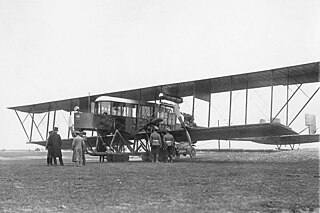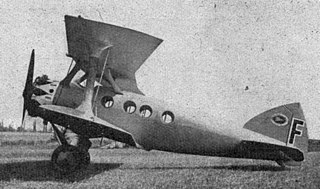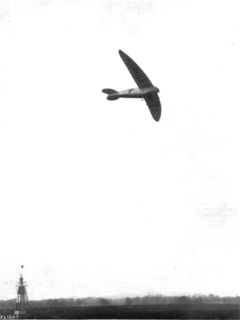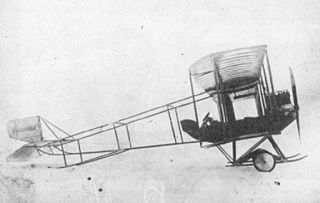
The Sikorsky Russky Vityaz, or Russian Knight (S-21), previously known as the Bolshoi Baltisky(The Great Baltic) in its first four-engined version, was the first four-engine aircraft in the world, designed by Igor Sikorsky and built at the Russian Baltic Railroad Car Works in Saint Petersburg in early 1913.

The Bloch MB.220 was a French twin-engine passenger transport airplane built by Société des Avions Marcel Bloch during the 1930s.

The Blériot-SPAD S.56 was a family of French airliners developed in the 1920s as various refinements of the S.33 design. All S.56 versions shared two new features: the first was a newly designed, all-metal wing, replacing the wooden wing of earlier related designs and the second was a redesigned passenger cabin, replacing the S.33's four single seats in a row with two rows of double seats. A second access door was also added.
The Pemberton-Billing P.B.25 was a First World War British single-seat scout aircraft built by Pemberton-Billing Limited, later Supermarine Aviation Works Limited.
The Sopwith Two-Seat Scout was a 1910s British biplane Anti-Zeppelin scout biplane designed and built for the Admiralty by the Sopwith Aviation Company. It was nicknamed the Spinning Jenny due to a tendency to enter a spin.

The Sikorsky S-16, or RBVZ S-XVI, was a Russian equi-span single-bay two-seat biplane designed by Igor Sikorsky in 1914-15. Conceived in response to demand for an escort fighter for the Ilya Muromets bombers, it was noteworthy in that it was one of the first aircraft to possess synchronisation gear for its 7.7 mm machine gun. The first S-XVI was completed on 6 February 1915 with an 80 hp engine instead of the intended 100 hp because of supply problems. On 17 December 1915, the Russian government placed an order for 18 aircraft, these being delivered in early 1916.

The Sikorsky S-20 or RBVZ S-XX was a Russian single-bay unequal span two-seat biplane designed by Igor Sikorsky in 1916. Displaying some Nieuport influence, it saw very little service during World War I.

The Sikorsky S-10 was a Russian military twin-float seaplane that served with the Russian Navy's Baltic Fleet from the summer of 1913 to 1915. After Igor Sikorsky built the successful Sikorsky S-6 for the Russian military, he tried to build another successful aircraft for them. The S-10 was a modified S-6B built by the Russo-Baltic Carriage Factory. Approximately sixteen production versions of the S-10 were built. It had a less powerful engine and generally weaker structure than the S-6. They had either an 80 hp Gnome Monosoupape or a 100 hp Argus Motoren engine. Some were deployed on the world's first operational seaplane carriers.

The Handley Page Type F was a two-seat, single-engined monoplane designed to compete for a War Office prize for a specified military machine in 1912. It crashed before the trials got under way and, although it flew well later, only one was built.

The Blériot 111 was a French four-seat executive transport monoplane designed by André Herbemont. The first French aircraft to be fitted with a retractable landing gear, after six years development it was not ordered into production.

The COW Biplane was a British tractor biplane built to compete in the 1912 British Military Aeroplane Competition. It was not successful.

The Short S.36 was a British two-seat tractor biplane, built by Short Brothers for Francis McClean in 1911. It was later developed into the Short S.41 and Short S.45, which were the first of a long series of similar aircraft built for the RNAS and RFC.

The Vertical Hummingbird is an American helicopter, produced by Vertical Aviation Technologies of Sanford, Florida that was introduced in 1991. The aircraft is supplied as a kit for amateur construction.
The Coelho AC-11 is a Brazilian homebuilt aircraft that was designed and produced by Altair Coelho of Eldorado do Sul and introduced in 1994. The aircraft was intended to be supplied as a kit for amateur construction, but only one was completed.

The Sikorsky S-8Malyutka (baby) was a small Russian single engine aircraft built by the Russian Baltic Railroad Car Works shortly after Igor Sikorsky became chief engineer of the aircraft manufacturing division in 1912.

The Sikorsky S-2 was the second fixed wing aircraft designed by Igor Sikorsky using the main wing section from the S-1 and a 25 hp (19 kW) Anzani 3 three-cylinder engine in a tractor configuration. During the first flight attempt on June 3, 1910, the biplane reached a height of two to four feet and traveled approximately 200 yards. After several successful flights the S-2 was completely destroyed on June 30 when Sikorsky inadvertently stalled the underpowered aircraft at an altitude of 70 feet.

The Sikorsky S-6 was a Russian single engine experimental aircraft similar to the S-5, built in 1911 by Igor Sikorsky.

The Sikorsky S-9Kruglyj was a Russian single engine prototype aircraft completed in the spring of 1913 by the Russian Baltic Railroad Car Works while Igor Sikorsky was the chief engineer of the aircraft manufacturing division.

The Sikorsky S-11 Polukroogly was a Russian single engine prototype reconnaissance aircraft completed in July 1913 by the Russian Baltic Railroad Car Works while Igor Sikorsky was the chief engineer of the aircraft manufacturing division.

The Sikorsky S-12 was a Russian single engine trainer aircraft completed in the spring of 1913 by the Russian Baltic Railroad Car Works while Igor Sikorsky was the chief engineer of the aircraft manufacturing division.


















